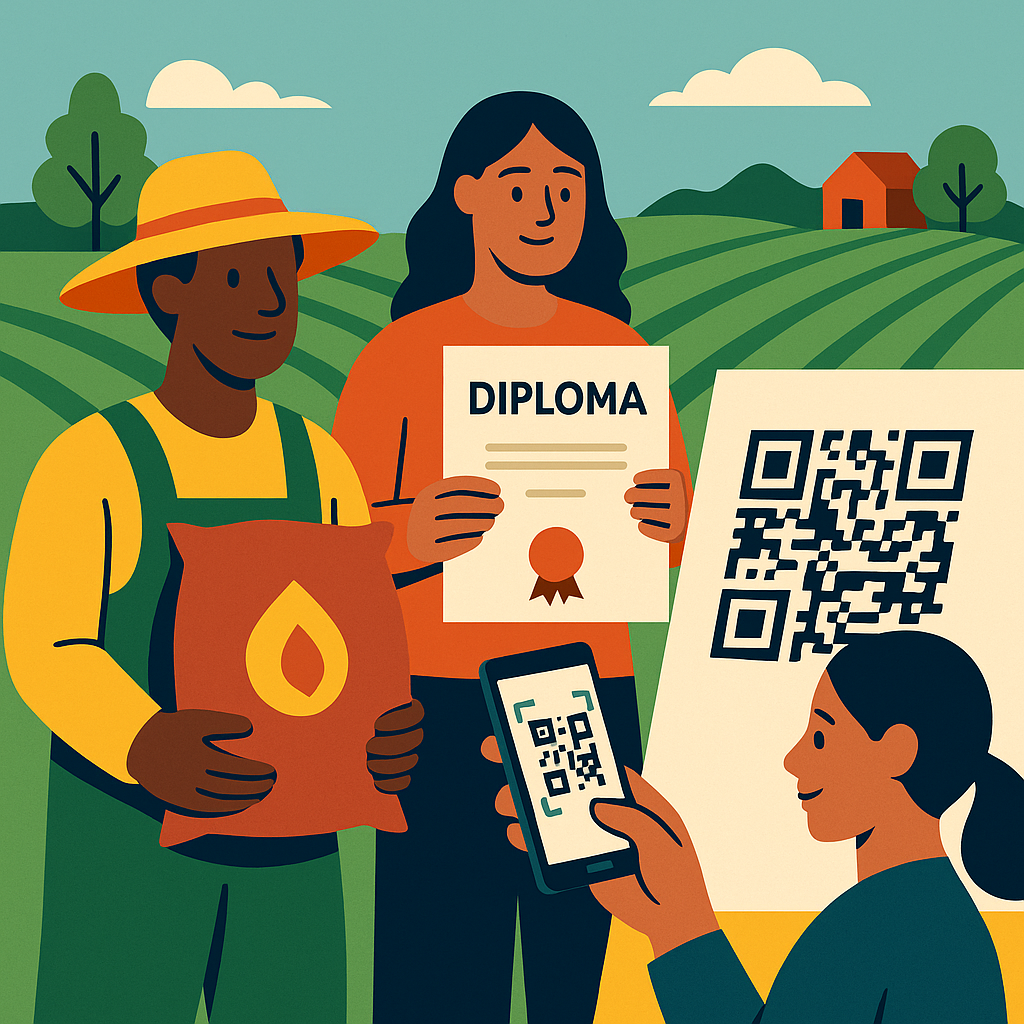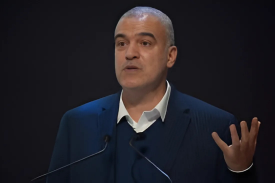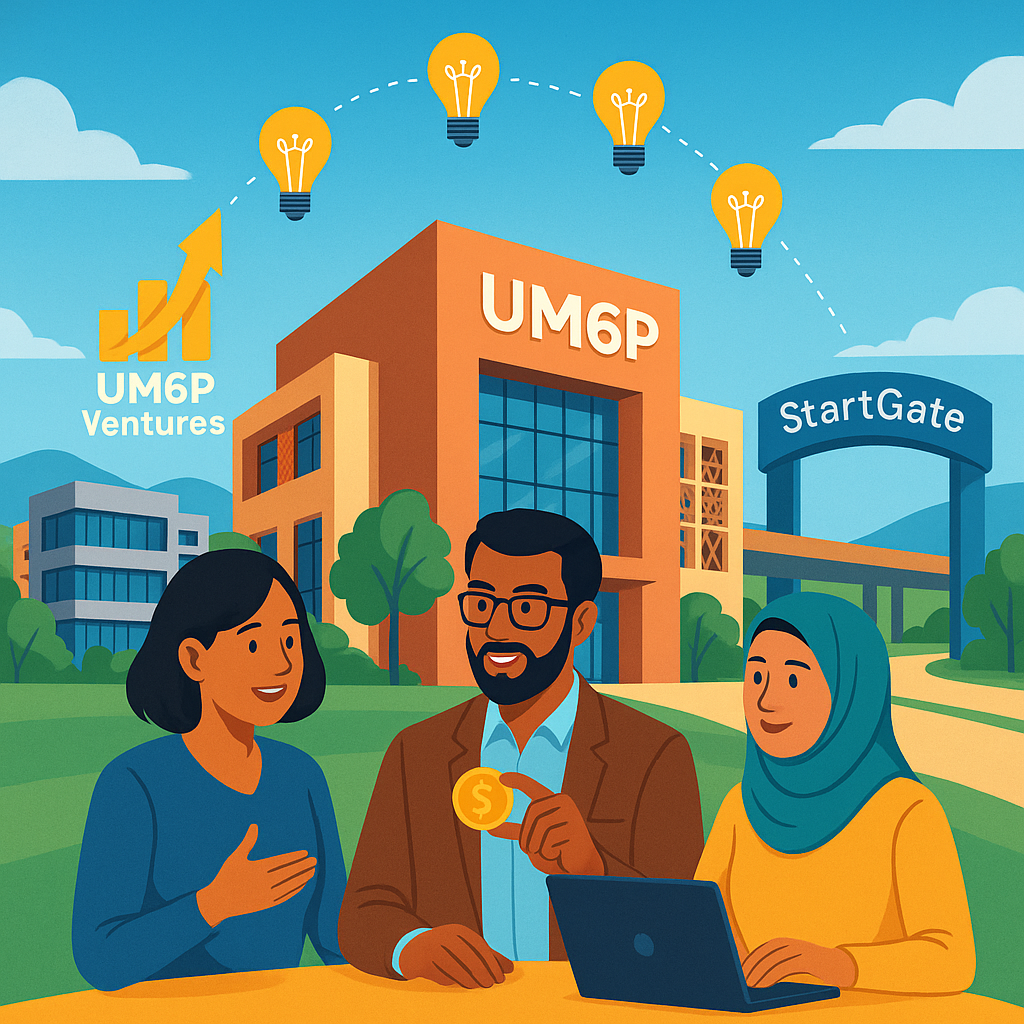Phygital: the best of both worlds

In a world seduced by the allure of a fully digital future, where paper was meant to vanish and every interaction was destined for the cloud, reality tells a different story; file cabinets still overflow, and farmers still trust the weight of a seed bag over an app. “The future isn’t digital or physical, it’s both,” says Rafiq El Alami, UM6P researcher and co-founder of SenseThings.
The digital revolution arrived with grand promises. Paper would disappear. Offices would become virtual. Every transaction, every record, and every interaction would migrate to the cloud. Yet walk into any government ministry, university, or agricultural cooperative today, and you will find file cabinets still packed with documents, warehouses still stacked with ledgers, and people still clinging to the physical artifacts of daily life.
This is not resistance to change. It is a reflection of deeper truths about how humans interact with information. A farmer in Kenya trusts the weight of a seed bag in his hands more than an app on his phone. A student in Morocco values the texture of her diploma as much as its digital counterpart. A factory manager in Germany keeps paper logs as a failsafe when servers go down.
The idea that these behaviors are relics of a bygone era—that they will inevitably fade as digital adoption spreads—is not just naive; it is dismissive of real-world constraints. The promise of digital transformation, it turns out, is incomplete.
But what if the choice between physical and digital is a false one?
This is the question that led Rafiq El Alami, a UM6P researcher and head of its Digital Innovation Center for Excellence (DICE), to co-found SenseThings, a startup that is not just challenging the dogma of digital absolutism but rewriting it entirely. His solution? Phygital evolution.
“The problem with digital transformation,” El Alami explains, “is that it assumes everyone starts from the same place. But in much of the world, connectivity is unreliable, electricity is intermittent, and trust in purely digital systems is fragile. Telling people to abandon physical systems entirely doesn’t work. It leaves them stranded.”
Phygital evolution is this seamless fusion of the physical and digital worlds, where objects are not replaced but enhanced, where resilience is built into the system, and where technology serves people rather than forcing them to adapt to its limitations.

Phygital: the best of both worlds
SenseThings’ innovation lies in its refusal to accept the false choice between physical and digital. The company’s core technology, called T3 (Trust, Track, and Trace), does not seek to replace physical objects with digital versions. Instead, it gives physical objects a digital identity—a kind of technological soul—that allows them to move fluidly between both worlds. The process is simple. Take any object—a university diploma, a bag of fertilizer, or a luxury handbag—and pass it through a kind of scanner (Phygitalizer) that captures its unique physical characteristics.

These attributes are then translated into a unique cryptographic signature, creating a digital twin that is permanently linked to the original.
The physical object remains unchanged, but it now carries with it an invisible layer of digital intelligence.
“It’s like a person’s fingerprint transformed into a digital format to identify them,” El Alami says. “We take any object, pass it through our phygitalizer, and extract a unique physical identity.” This approach solves problems that purely digital systems cannot. Consider academic credentials.
Diploma fraud is a global challenge, costing universities and employers billions annually. Pure Digital credentials have been touted as the solution, yet adoption remains slow. Why? Because they require institutions and employers to fully abandon paper, a leap many are unwilling or unable to make.
SenseThings’ phygital diplomas require no such sacrifice. The paper certificate remains valid, but now it can be instantly verified via smartphone. If the internet is down, the physical document still works. If the paper is lost, the digital record persists. “We’re not asking people to change their behavior,” El Alami says. “We’re giving them more options, not fewer.”
Why “Phygital” Beats “Digital”
The real test of any technology is not its elegance but its impact. Here, SenseThings’ results are striking. Within two years of its founding, the company’s system was adopted by Morocco’s Ministry of National Education for all baccalaureate certificates and transcripts. Private universities followed. Today, the platform processes millions of credentials annually.
“Our biggest competitors, who preach digital transformation and tell people to abandon physical diplomas, are failing to penetrate Morocco or Africa,” El Alami asserts. “In two years, we’ve matched their decade-long global output. Why? Because our approach reconciles physical with digital, delivering the best of both worlds.”
This “best of both worlds” philosophy is more than a tagline. it’s a masterstroke. Traditional digital credential providers advocate for fully digital systems, which often clash with cultural and practical realities in developing nations. Paper diplomas carry symbolic weight, and abandoning them risks alienating stakeholders.
T3, by contrast, keeps the physical diploma while adding a digital twin that enables instant verification. “When I approach the Ministry of Education, I don’t say ‘abandon paper diplomas,’” El Alami explains. “I say, ‘You’ll keep those, but also get a digital version.’ Universities can instantly verify authenticity, and adoption is five to six times faster.”
The impact is tangible. For students, instant verification accelerates university admissions and job applications. “If one candidate’s diploma takes five weeks to verify versus another’s instant validation, the faster option gets chosen,” El Alami notes. In a competitive global education market, this speed can open doors that were previously closed. Beyond Morocco, SenseThings is eyeing expansion across Africa, where credential fraud costs economies billions annually.
But education is just the beginning. In agriculture, where counterfeit seeds and fertilizers cost African farmers billions each year, SenseThings’ phygital tags allow farmers to verify authenticity with a smartphone scan. In luxury goods, where counterfeit handbags and watches plague the industry, the same technology enables brands to embed unforgeable proof of origin. In each case, the physical product remains central—but now it speaks the language of the digital age.

While education was the starting point, SenseThings’ ambitions extend far beyond. The company’s second vertical, smart packaging, is poised to disrupt agriculture, logistics, and manufacturing.
Using T3, SenseThings creates digital twins for packaged products, embedding data on manufacturing dates, distribution chains, component sourcing, and dynamic carbon footprints. “We’re working on phyigital fertilizer bags, and other industrialists are very interested in the novel approach,” El Alami reveals.
The value lies in supply chain transparency. Consumers gain access to real-time data—such as batch origins or environmental impact—while producers can engage directly with end-users through loyalty programs or feedback loops. “It eliminates traditional barriers between manufacturers and end-users,” El Alami says. “Producers gain customer insight, and consumers get tailored products.”
A New Model for Innovation
What makes SenseThings particularly compelling is not just its technology but where it comes from. Too often, solutions for the developing world are watered-down versions of technologies designed for Silicon Valley or London. SenseThings reverses this dynamic. Born in Morocco, where unreliable infrastructure and deep-seated trust in physical systems are daily realities, its approach is tailored to environments where purely digital solutions fail.
Yet these constraints have birthed a solution with universal appeal. After all, power outages happen in Berlin as well as Bamako. Paper records persist in Washington as they do in Nairobi. By building for the edge cases, SenseThings has created a system that works everywhere.

We stand at an inflection point. For years, the tech industry has pushed us toward an all-digital future, dismissing physical systems as outdated. SenseThings offers a more nuanced vision—one where physical and digital are not rivals but partners.
This is more than just a technical shift. It is a philosophical one. It acknowledges that human beings are tactile creatures, that trust is often built through physical interaction, and that resilience comes from redundancy. In a world racing toward digital abstraction, SenseThings reminds us that sometimes the most advanced solutions are those that keep us grounded.
As El Alami puts it, “The future isn’t about choosing between atoms and bits. It’s about making them work together in ways that respect how people actually live.” In that simple idea lies the seed of a revolution—one that begins in Morocco but may well reshape the world.
Africa as a Deep Tech Powerhouse
SenseThings’ success is inseparable from its roots in UM6P. UM6P Ventures, the university’s investment arm, has poured millions of dollars into 27 startups, with SenseThings as a flagship.
The university’s ecosystem—complete with incubators like StartGate and partnerships with global accelerators like Plug & Play, provides a rare blend of research infrastructure, talent, and market access.
“We bootstrapped via UM6P Ventures, incubated at StartGate, and now serve UM6P and other moroccan customers while scaling beyond Morocco and Africa,” El Alami says.

This ecosystem is a microcosm of Africa’s deep tech potential. Sensthings is trailblazing the deeptech sector in Africa, and highlighting that Africa’s innovation is not restricted to consumer Apps and platforms but can include hard tech, UM6P’s research ecosystem allow soltutions like T3 to be grounded in scientific breakthroughs. “Our research-to-market pathway began with rigorous patents and papers,” El Alami explains. “Now, market feedback informs new research, creating a virtuous cycle.” This iterative approach has led to additional patents, ensuring SenseThings stays ahead of the curve.
Yet, scaling deep tech in Africa faces systemic hurdles. “Most African VCs lack the capacity to evaluate deep tech solution,” El Alami laments. “UM6P Ventures is pioneering here, but broader investor education is needed.” Legal frameworks also lag, with cumbersome hiring and equity rules stifling startups. El Alami advocates for startup-friendly policies and tech transfer incentives to smooth the university-to-market pathway. “At UM6P, we’re creating these, but it needs to be continent-wide,” he says.
T3’s impact extends to data sovereignty, a pressing issue as nations grapple with digital colonialism. “True sovereignty isn’t just local data storage,” El Alami argues.
“It’s about producing exportable tech that solves local problems globally.” SenseThings’ use of UM6P’s sovereign data center ensures local control, but its real triumph is its exportable model. Recognized by the World Summit Award ( A UN Initiated initaitve) as a blueprint for trusting local deep tech, T3 reduces reliance on foreign solutions, cuts costs, and scales internationally.
This model challenges the narrative that innovation must originate in the West. Morocco’s success with T3 – praised by the Arab League and UN – shows how the Global South can lead. “The WSA noted Morocco’s approach as worth replicating,” El Alami says. “Local innovation builds trust, like the Ministry adopting homegrown tech.” In contrast, foreign solutions often come with higher costs and cultural disconnects.
EL Alami’s vision is audacious: to create Africa’s first deep tech unicorn. “All ingredients exist,” he insists. “Novel IP, market traction, and Moroccan talent.” SenseThings’ T3 challenges 30-year digital transition norms, with proven success in education and packaging. Its international expansion – targeting Africa, the Middle East, and North America – signals confidence.
📄 Download the PDF version
Phygital: the best of both worlds
Curious to read the full article offline or share it with your network?
👉 Download the PDF version here


Leave a Reply